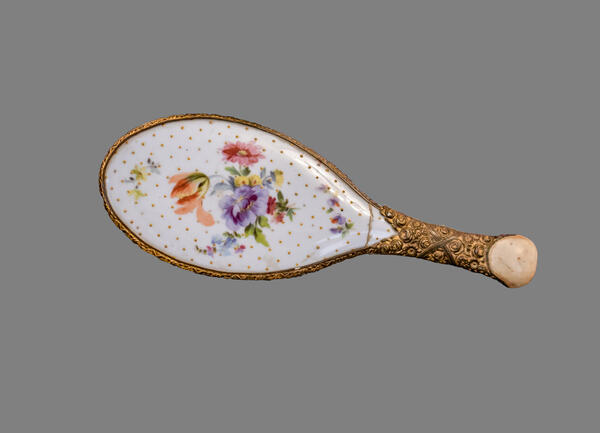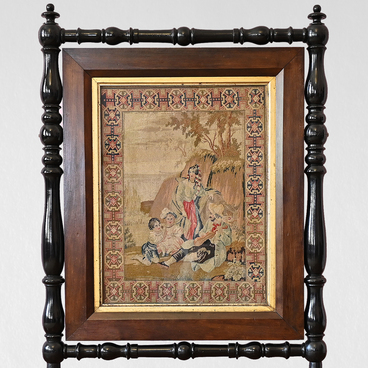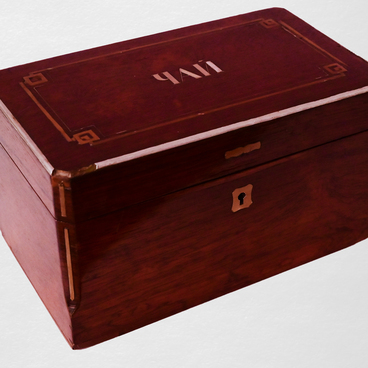The Tchaikovsky Museum Estate acquired the hairbrush in December 1989. It is presented in the exhibition of the composer’s childhood home along with other 19th–century women’s accessories, which are displayed on the dressing table in the parents’ bedroom.
The oval-shaped brush body features a long handle. The front side has a decorative enamel overlay: a floral bouquet surrounded by numerous golden dots is depicted on a white background. Natural bristles are attached to the wooden ivory base from the inside. The surface of the handle and body along the edges are decorated with a bronze overlay with an engraved pattern in the form of roses. The handle tip is made of bone.
Researchers consider that the first prototype of a modern hair brush was patented in the USA by Hugh Rock in 1854. And in 1870, another inventor, Samuel Firey, made a slightly modified version. The hairbrush, which was the most similar to the modern items, was patented in 1898 by an African-American inventor Lyda Newman. Her model had bristles separated wide enough to allow for easy combing.
Authors of 19th–century fashion magazines often published tips on proper haircare. To increase the air flow to the hair, it was proposed to “ventilate” it, using a comb, as well as from time to time to use a special rectangular brush and then an ivory comb with very thin teeth.
It was recommended to comb the hair in the direction in which it grows. Twisting and tightening curls was considered harmful. Some ladies considered soft brushes more useful, since they do not injure the skin; others preferred hard ones that could better massage the head. Electric and magnetic brushes and curling irons appeared by the end of the 19th century. The brushes, like other household items, were decorated with intricate patterns, mother-of-pearl and inlay.
Nowadays, most of the cases and handles for brushes are made of plastic or wood, and in the past centuries, they were made of metal, baleen or ivory. Antique brushes were made of animal bristles, for example, pigs and horses. In modern combs they are replaced by nylon, in rare cases — stainless steel.
The oval-shaped brush body features a long handle. The front side has a decorative enamel overlay: a floral bouquet surrounded by numerous golden dots is depicted on a white background. Natural bristles are attached to the wooden ivory base from the inside. The surface of the handle and body along the edges are decorated with a bronze overlay with an engraved pattern in the form of roses. The handle tip is made of bone.
Researchers consider that the first prototype of a modern hair brush was patented in the USA by Hugh Rock in 1854. And in 1870, another inventor, Samuel Firey, made a slightly modified version. The hairbrush, which was the most similar to the modern items, was patented in 1898 by an African-American inventor Lyda Newman. Her model had bristles separated wide enough to allow for easy combing.
Authors of 19th–century fashion magazines often published tips on proper haircare. To increase the air flow to the hair, it was proposed to “ventilate” it, using a comb, as well as from time to time to use a special rectangular brush and then an ivory comb with very thin teeth.
It was recommended to comb the hair in the direction in which it grows. Twisting and tightening curls was considered harmful. Some ladies considered soft brushes more useful, since they do not injure the skin; others preferred hard ones that could better massage the head. Electric and magnetic brushes and curling irons appeared by the end of the 19th century. The brushes, like other household items, were decorated with intricate patterns, mother-of-pearl and inlay.
Nowadays, most of the cases and handles for brushes are made of plastic or wood, and in the past centuries, they were made of metal, baleen or ivory. Antique brushes were made of animal bristles, for example, pigs and horses. In modern combs they are replaced by nylon, in rare cases — stainless steel.



